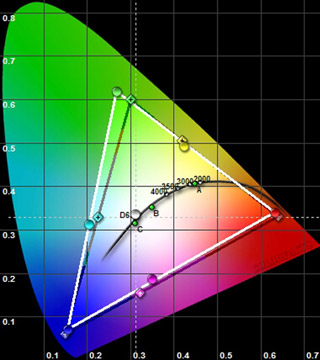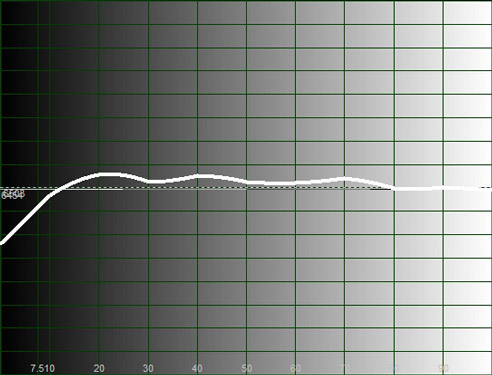Panasonic is a tough company – it takes them a
long time to adopt things like native rate support. 24fps is a must these
days, and this new series supports it like a champ. However, native rate
support (at 60 Hz and 50 Hz) via HDMI is still MIA.
The contrast ratio of 10,000:1 is a tough nut to
crack. Many companies use this number, but in reality no one really comes
close. The number is a figment of optimistic projectionism on part of
overeager number crunching advertising executives. The number meshes both
static (ANSI) contrast ratios with dynamic contrast ratios achieved by
contrast stretching and various other nifty techniques. The actual panel
contrast ratio is roughly 2000:1, which means that even with a typical
200-250% dynamic contrast ratio, the actual contrast ratio for this display
is realistically more like 5000:1 at most. But, 5000:1 is not bad at all.
Interestingly, all of the new panels by
Panasonic and other companies are limited by the brightness (dividend side of
the division formula). That means companies are likely solving the
blackness problem (reaching deep blacks on thin panels is a key problem) by
inserting a dark filter – which reduces the amount of light on both bright
and dark images. Another likely explanation is that the longer life spans
(between 60,000 and 100,000 hours to half brightness) are achieved by close
monitoring of the panel brightness and by preventing the display from
reaching high brightness and burning itself out quicker.
Fill ratios on this panel are much better than
previous models, but the fact is that this plasma requires some distance for
proper viewing (12 or so feet would be ideal).
The Viera series, in contrast with Panasonic's
professional models (PHD10) suffer from a lack of calibration modes and
options. When selecting "Color Management OFF", the unit actually refers to
a normal color gamut, while the ON mode extends the color gamut by a small
amount. In both conditions, the gamut is quite far from the REC601 and
REC709 specs.
 |
 |
| "Color Management" Off |
"Color Management" On |
The display lacks any gamma controls, so in a
paraphrase of Heny Ford's famous saying: you can have any gamma you want as
long as it's 1.92. Unfortunately, this number is quite low and although it
reveals quite a lot of detail, it does leave a milky and unstriking image
that could have been enhanced by a more striking gamma curve.

Looking at the PV700's spectral graph, it has
a virtually identical signature to Panasonic's older models. This means that
the phosphor makeup of this model is the same, and that the improvements in
the new generation are mostly in how the plasma cells are structured.

Calibration wise, this display came almost
pre-calibrated, with an average 5% mismatch for D65 calibration. This is quite
impressive for a display not necessarily intended for pro-sumers, but for
popular use.


As I mentioned before, the display lacks any
native rate support for its HDMI inputs, which is unfortunate for users
wanting to add an external scaler or hook up an HTPC to the unit.
The various formats worked perfectly,
including 1080p at 24 fps. All ATSC formats worked out of the box using both
60 Hz (US) and 50 Hz (Europe) frequencies.
A blaring omission for the European market is
the missing SCART (a popular European connector).
Go to Part III.